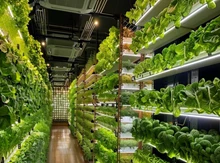
California's ageing infrastructure has allowed much of the rainfall to run into the Pacific Ocean after the drought-stricken state was abruptly swamped by a series of rainstorms. During this extremely rainy year, Cameron estimates his facility is returning 8,000 to 9,000 acre-feet of water to the land weekly, from both rains and melted snowpack. There is enough water to supply 16,000 to 18,000 urban families for a year.
"When we first started doing this, our neighbours thought we were insane. Everyone we spoke with predicted that we would destroy the crop. But believe me, everything turned out wonderful," said Cameron, vice president and general manager of Terra Nova Ranch, a 6,000-acre (2,400-hectare) farm in the San Joaquin Valley that grows wine grapes, almonds, walnuts, pistachios, olives, and other crops.
If more farmers inundated their fields instead of diverting precipitation into flood channels, the excess water may seep underground and be saved for when drought conditions return. California is experiencing both devastating drought and destructive flooding. This season has been exceptionally stormy, with 12 atmospheric rivers hammering California since late December, making flood mitigation even more important. Further rain is expected in the next week.
Cameron stated that the basins at Terra Nova are full with 1.5 to 3.5 feet of water. He intends to flood 530 acres of pistachio trees and 150 acres of wine grapes, as well as another 350 acres planted solely when there is excess floodwater available.
The state Department of Water Resources contributed USD 5 million to the project, which includes a pumping system, while Terra Nova contributed another USD 8 million. According to Cameron, the corporation has received essentially no return so far, though it may obtain future water rights for its groundwater contributions.
Cameron is "unquestionably the godfather of on-farm recharge." He's truly the pioneer who started it first," said Ashley Boren, CEO of Sustainable Conservation, an environmental organization that supports sustainable groundwater management. According to experts, emulating nature by allowing water to flow across the landscape is the most cost-effective strategy to manage peak flood flows while storing the surplus for dry days. "Not only will it benefit us, but it will also benefit our neighbours," Cameron explained.
Cameron began his 30-year-old passion project before the state implemented the Sustainable Groundwater Management Act (SGMA) of 2014, a statute designed to avert an impending tragedy caused by overdrafts. Policymakers have since worked on economic incentives to encourage other farms to follow suit. Some water districts in charge of SGMA implementation have granted growers credits towards water rights in exchange for recharging. State legislation in the works would make permitting easier and ensure water rights for participating producers.
On March 10, California Governor Gavin Newsom signed an executive order allowing farmers to redirect floodwaters onto their property until June. There is no statewide monitoring of on-farm recharge, but Sustainable Conservation is tracking 260 farmers refilling their aquifers this year, releasing at least 50,000 acre-feet (61.7 million cubic metres) back into the ground as of mid-February.
California recently gave USD 260 million in subsidies to Groundwater Sustainability Agencies established under SGMA, with a strategic goal of creating 4 million acre-feet of storage. According to Paul Gosselin, deputy director of the state's Sustainable Groundwater Management Office, the state received proposals asking USD 800 million, showing a desire for projects. Growers confront other challenges to on-farm recharging in addition to expense. A farm must have access to water, must not harm endangered species, and must not flood land that has been exposed to particular fertilizers, pesticides, or dairy farm waste.
According to Daniel Mountjoy, director of resource stewardship for Sustainable Conservation and a participant in a state study, interested farmers in the Merced River Watershed might recapture enough future floodwater to replace 31% of the groundwater they are overdrafting under current conditions. He believes that with adjustments in reservoir management and infrastructure upgrades, that figure might rise to 63%.
Mountjoy estimates that 750,000 to 1 million acres of irrigated farmland would have to be fallowed to attain sustainability throughout the San Joaquin Valley. "We're just getting started with groundwater recharge programmes," said Gosselin of the state groundwater office.











